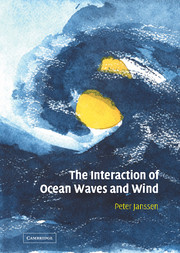2 - The energy balance of deep-water ocean waves
Published online by Cambridge University Press: 06 October 2009
Summary
In this chapter we shall try to derive, from first principles, the basic evolution equation for ocean-wave modelling which has become known as the energy balance equation. The starting point is the Navier–Stokes equations for air and water. The problem of wind-generated ocean waves is, however, a formidable one, and several approximations and assumptions are required to arrive at the desired result. Fortunately, there are two small parameters in the problem, namely the steepness of the waves and the ratio of air density to water density. As a result of the relatively small air density, the momentum and energy transfer from air to water is relatively small so that, because of wind input, it will take many wave periods to have an appreciable change of wave energy. In addition, the steepness of the waves is expected to be relatively small. In fact, the assumption of small wave steepness may be justified a posteriori. Hence, because of these two small parameters one may distinguish two scales in the time–space domain, namely a short scale related to the period and wavelength of the ocean waves and a much longer time and length scale related to changes due to small effects of nonlinearity and the wind-induced growth of waves.
Using perturbation methods, an approximate evolution equation for the amplitude and the phase of the deep-water gravity waves may be obtained.
- Type
- Chapter
- Information
- The Interaction of Ocean Waves and Wind , pp. 7 - 55Publisher: Cambridge University PressPrint publication year: 2004
- 1
- Cited by



